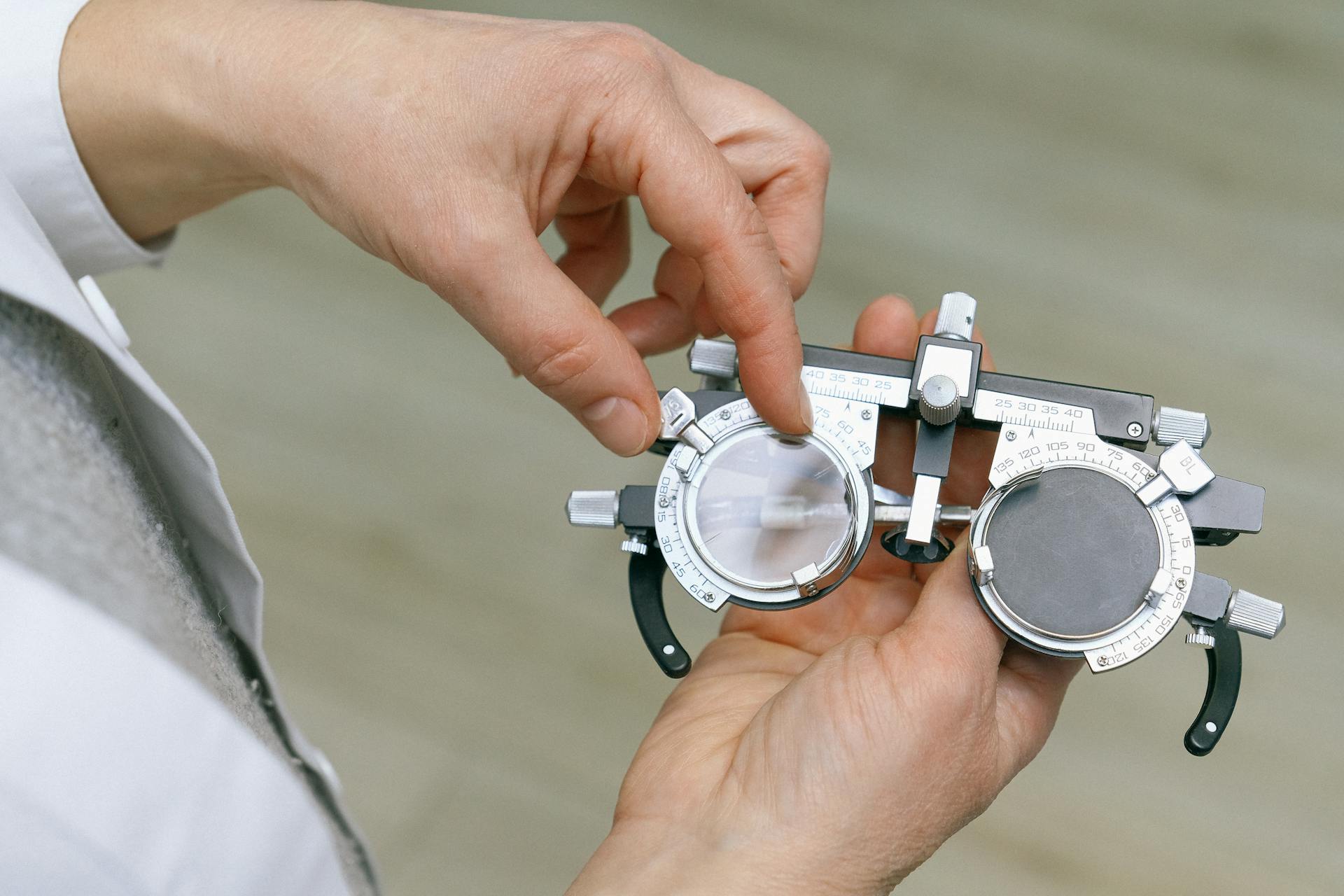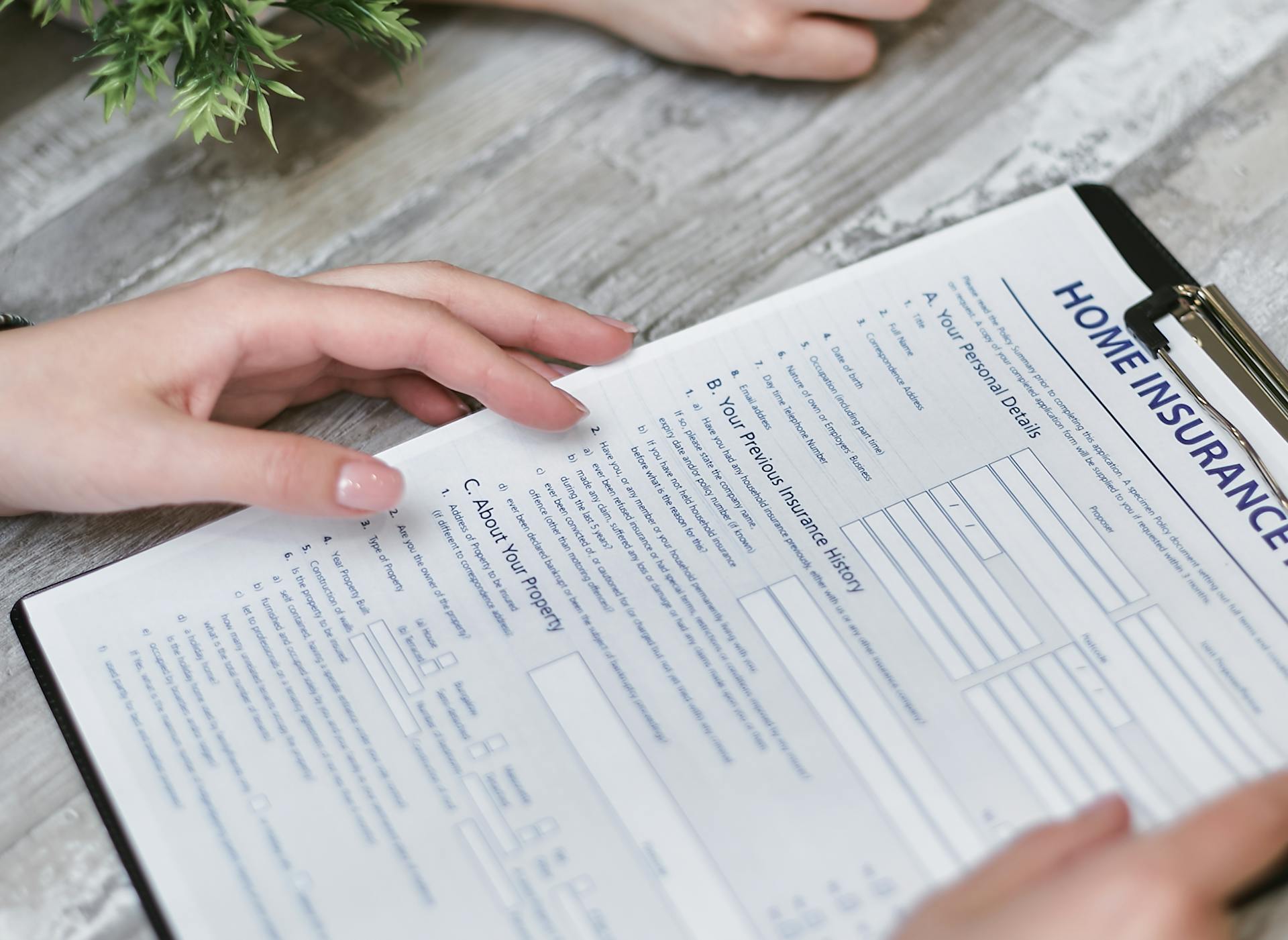
Becoming a desk claims adjuster can be a rewarding career, offering a stable income and opportunities for advancement. Desk claims adjusters work with insurance companies to evaluate and settle claims.
To get started, you'll typically need a high school diploma or equivalent, and most employers prefer candidates with a degree in a field like business, communications, or a related field. Many desk claims adjusters also hold professional certifications, such as the Certified Insurance Service Representative (CISR) or the Associate in Claims (AIC) designation.
As a desk claims adjuster, you'll spend most of your time working in an office, analyzing data and communicating with policyholders, agents, and other stakeholders. You'll need strong analytical and problem-solving skills to navigate complex claims and negotiate settlements.
A different take: Field Claims Adjuster
Types of Desk Claims Adjuster Roles
As you navigate the world of insurance claims, you may come across different types of desk claims adjusters. They play a crucial role in overseeing the entire claim experience.
A desk adjuster's primary function is to work on behalf of the insurance company, overseeing the claim process and communicating with you throughout.
You'll likely interact with a desk adjuster primarily through phone calls, emails, or text messages. They're the ones who will guide you through the process and keep you informed about the status of your claim.
Here's a breakdown of the different roles you might encounter:
- Desk adjusters work for the insurance company and oversee the claim on their behalf.
- Field adjusters, who may work for the insurance company or be contracted on their behalf, travel to the location of the loss to collect more detailed information and provide it back to the desk adjuster.
- Public adjusters, on the other hand, are hired by you and act as a representative on your behalf, often requiring a fee for their service.
Insurance Industry Knowledge
As a desk claims adjuster, it's essential to have a solid understanding of the insurance industry. Adjusters play a crucial role in helping customers navigate the complexities of their policies.
Most policies provide a claim payout for the actual cash value of lost, stolen, or damaged property, but what's often overlooked is the concept of recoverable depreciation. This allows policyholders to replace or repair their loss and recover the difference in cost by showing that they completed the repair or replaced the item.
To become a skilled desk claims adjuster, consider enrolling in the Haag Certified Reviewer Program. This program offers up to four levels of certification, covering topics such as construction, damage identification, software, and policy. It's designed to prepare individuals for desk adjuster roles and is geared towards those who have never seen this stuff before.
Here are the 4 pillars of liability that you'll need to understand as a desk auto liability adjuster:
- Duty Owed
- Duty Breached
- Right of Way
- Possession of Roadway
To complete an auto liability claim, you'll need to follow 12 steps, which include reviewing the claim and coverages, obtaining and reviewing police reports, and writing up your liability decision/report.
Curious to learn more? Check out: Liability Claims Adjuster
Insurance Nuances
Adjusters are experts at explaining the complexities of insurance policies to customers. They can help you understand everything from deductibles to recoverable depreciation.
Recoverable depreciation is a key concept that many homeowners are unaware of. It allows you to replace or repair a loss and recover the difference in cost by showing that you completed the repair or replaced the item.
Endorsements, managed repair programs, and home warranties are just a few of the many things your adjuster can help you navigate. They can explain the ins and outs of each and help you make informed decisions.
The 5-night Desk Auto Liability Adjuster Certification is a valuable training program that puts liability principles into practice. It's a $2000 value that can help you gain the skills and knowledge you need to succeed in the insurance industry.
What's Included in IA Path Auto Liability Certification
The IA Path Auto Liability Certification is a comprehensive program that covers all aspects of liability investigation and claims handling. You'll learn from a 15+ year veteran instructor and your classmates over the course of a 5-night class, Monday through Friday from 8pm-10pm EST.
The certification process involves executing every step of a liability investigation and proving your ability to properly complete a liability claim as an adjuster. This is a $2000 value, but you'll get hands-on experience and expert guidance to help you succeed.
Worth a look: Gds Claims - Public Adjuster
To prepare for the certification, you'll need to complete the Auto Damage Collision Masterclass, a 20+ hour on-demand video training that covers the foundational understanding of auto damage assessment and completion in the field. This is a prerequisite for the Desk Auto Liability Adjuster Certification and has a value of $2500.
The 5-night certification process breaks down the liability investigation process into 12 steps, which you'll need to complete successfully to earn your certification. These steps include reviewing the claim and coverages, obtaining and reviewing police reports, and writing up your liability decision/report.
Here are the 12 steps to complete an auto liability claim as an independent adjuster:
- Review the Claim & Coverages
- Review/Obtain Statements
- Obtain & Review Police Report
- Review Damage Estimate & Photos
- Determine What Duty Was Owed By Each Driver
- Determine What Duty Was Breached By Each Driver
- Determine Who Had the Right of Way
- Determine Who Had Possession of the Roadway
- Write Up Your Liability Decision/Report
- Complete the Exchange of Information With Other Party
- Bargain and Negotiate Final Decision/Settlement
- Close the File and Settle the Claim
Additionally, the Liability Crash Course introduces you to the 4 pillars of liability: Duty Owed, Duty Breached, Right of Way, and Possession of Roadway.
Claims Adjuster Skills and Training
To become a desk claims adjuster, you'll need to develop a strong understanding of liability principles. This can be achieved through training programs like the 5-Night Workshop Style Liability Training & Certification, which puts into practice the principles of liability and allows you to execute every step of a liability investigation.
The Auto Damage Inspection & Estimating Training is also a valuable resource, teaching you everything about how auto damage is assessed and completed in the field. This lays a foundational understanding for auto liability claims and is a pre-requisite to the Desk Auto Liability Adjuster Certification.
To become certified, you'll need to complete a 5-night certification process, which teaches you how to complete an auto liability claim in 12 steps. These steps include reviewing the claim and coverages, obtaining and reviewing police reports, and determining who had the right of way.
Related reading: Certification for Claims Adjuster
Haag Certified Reviewer Program
The Haag Certified Reviewer Program is a game-changer for those looking to break into desk adjuster roles. This comprehensive training is specifically designed to equip you with the skills and knowledge needed to succeed as a desk adjuster.
The program offers up to four levels of certification, covering construction, damage identification, software, and policy knowledge. It's basically a desk adjuster certification, but don't let the name fool you – it's a robust program that will fully prepare you for the role.
On a similar theme: Cocobolo Desk
Haag Education has partnered with industry leaders to create this program, ensuring it's tailored to meet the needs of carriers, IA firms, contractors, and more. This means you can trust that the training is relevant and effective.
Here are the four levels of certification offered by the Haag Certified Reviewer Program:
- Level 1: Getting started
- Level 2: Building expertise
- Level 3: Intermediate training
- Level 4: Advanced, role-specific training
The program is geared towards those who are new to the industry, but want to get into desk-specific work. It's also a great option for field adjusters who want to upskill or reskill from home. And the best part? It's not expensive, with a discount available for those who use the code ADJUSTERTV.
IA Path Auto Damage Certification Syllabus
The IA Path Auto Damage Certification Syllabus is a 5-night certification process that teaches you how to complete an auto liability claim in 12 steps. You'll earn the Desk Auto Liability Adjuster Certification by demonstrating competency in these steps.
The 12 steps to complete an auto liability claim as an independent adjuster are:
- Review the Claim & Coverages
- Review/Obtain Statements
- Obtain & Review Police Report
- Review Damage Estimate & Photos
- Determine What Duty Was Owed By Each Driver
- Determine What Duty Was Breached By Each Driver
- Determine Who Had the Right of Way
- Determine Who Had Possession of the Roadway
- Write Up Your Liability Decision/Report
- Complete the Exchange of Information With Other Party
- Bargain and Negotiate Final Decision/Settlement
- Close the File and Settle the Claim
The Liability Crash Course introduces you to the 4 pillars of liability, which are:
- Duty Owed
- Duty Breached
- Right of Way
- Possession of Roadway
This certification process will give you a solid foundation in completing auto liability claims and prepare you for a career as a desk adjuster.
Claims Adjuster Work and Responsibilities
As a desk claims adjuster, your work involves reviewing open claims and working to resolve them promptly. Good adjusters spend much of their time checking to confirm that the process is coming to a resolution.
You'll be responsible for scheduling field adjuster visits if necessary, confirming receipt of documentation, and following up on contractor visits. This ensures that the claim is moving forward and the process is efficient.
In some cases, you'll be instructed to try to close the file over the phone, which means you'll need to gather information from the insured, such as measurements and photos, to make a coverage decision.
What Is Cycle Time?
Cycle time is the amount of time from when the homeowner files the claim until the time they have a decision made on their claim or money in their hand. This is a key metric for companies, as it directly affects the customer experience.
Typically, the clock stops when you're settling up with the insured either in person or on the phone, which is when the adjuster's work is considered complete. This is the point at which the claim is uploaded back into XactAnalysis or to the IA firm for further processing.
Readers also liked: Can You Be a Part Time Insurance Agent
As independent adjusters, our goal is to shorten the time it takes us to be able to give the homeowner a decision on their claim and what the next steps will be. This is when the clock stops for us, and we can consider the cycle time complete.
The faster the cycle time, the better the customer experience. Homeowners want someone to call them right away, within 24 hours of filing the claim, to answer their questions, make a coverage decision, and hand them a check.
Contractor Request Review
As an insurance adjuster, one of the key responsibilities is reviewing supplemental contractor requests. This involves collecting information about the loss or property damage and writing an initial estimate to resolve the claim.
The initial estimate may not always be accurate, and the contractor may discover more extensive damage than initially thought. In this case, the contractor can propose additional work necessary to properly repair the damage and submit it to the insurance company.
The adjuster is responsible for reviewing this proposal, providing approval, and adjusting the claim payout. This is an important step in ensuring that the claim is settled fairly and that the homeowner receives the necessary repairs.
Here's a checklist of what an adjuster looks for when reviewing a supplemental contractor request:
- Is the additional work necessary to properly repair the damage?
- Is the proposal approved by the insurance company?
- Are the claim payouts adjusted accordingly?
By following this checklist, adjusters can ensure that the claim is settled efficiently and effectively.
Frequently Asked Questions
How much does a desk adjuster make?
A Desk Adjuster's average annual salary is around $81,643, with a total estimated pay of $92,184. Learn more about the role and compensation on our website.
Sources
- https://www.dfs.ny.gov/apps_and_licensing/agents_and_brokers/lic_app_ia_pa
- https://sagesure.com/insurance-insights/what-does-an-insurance-adjuster-do/
- https://adjustertv.com/posts/sixfiguredeskadjuster
- https://iapath.com/liability-adjuster-certification/
- https://www.theclm.org/Magazine/articles/desk-adjusting-catastrophe-claims/821
Featured Images: pexels.com


